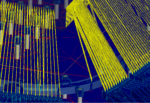The nearly unavoidable truth about dynamic voltage drop (DVD) signoff for power distribution networks (PDN) is that the quality of results depends on the quality and quantity of the vectors used to activate the circuit switching. As SOCs grow larger and are implemented on smaller nodes, the challenges of sufficient coverage … Read More
Bonds, Wire-bonds: No Time to Mesh Mesh It All with Phi Plus
Automatic adaptive meshing in HFSS is a critical component of its advanced simulation process. Guided by Maxwell’s Equations, it efficiently refines the mesh to accurately capture both the geometric and electromagnetic detail of a design. The end result is a process that guarantees accurate and reliable simulation results… Read More
Optical I/O Solutions for Next-Generation Computing Systems
According to DARPA the fraction of total power consumed in semiconductors for I/O purposes as been growing rapidly and is creating an I/O power bottleneck. It has reached the point where it needs to be addressed with new technologies and approaches. Interestingly, while the energy density, as measured by pJ/bit for short reach… Read More
Neural Network Growth Requires Unprecedented Semiconductor Scaling
The truth is that we are just at the beginning of the Artificial Intelligent (AI) revolution. The capabilities of AI are just now starting to show hints of what the future holds. For instance, cars are using large complex neural network models to not only understand their environment, but to also steer and control themselves. For… Read More
SeaScape: EDA Platform for a Distributed Future
The electronic design community is well aware that it faces a daunting challenge to analyze and sign off the next generation of huge multi-die 3D-IC systems. Most of today’s EDA tools require extraordinary resources in specialized computers with terabytes of RAM and hundreds of processors. Customers don’t want to keep buying… Read More
Ansys Talks About HFSS EM Solver Breakthroughs
Ansys HFSS™ has long enjoyed industry respect as a highly accurate electromagnetic simulator suitable for general purpose applications. Ansys has worked over the years to maintain its gold reference accuracy, and also to dramatically improve its performance and ease of use. A very interesting review of the key technology breakthroughs… Read More
Ansys IDEAS Digital Forum 2021 Offers an Expanded Scope on the Future of Electronic Design
For those of you following the latest developments in electronic design it has become clear that the industry is transitioning through an inflection point that is shifting some of the ground rules of design. The increase in the speed and integration density in today’s systems are blurring the lines between chip design and system… Read More
Have STA and SPICE Run Out of Steam for Clock Analysis?
At advanced nodes such as 7 and 5nm, timing closure and sign off are becoming much more difficult than before at 16nm. One area of chips that has increased in complexity dramatically and who’s correct operation is essential for silicon success is the clock tree. If the clock tree has excessive jitter, it will throw off every timing… Read More
Extreme Optics Innovation with Ansys SPEOS, Powered by NVIDIA GPUs
Optical engineers rely on Ansys SPEOS to deliver extreme product innovation — and NVIDIA dramatically accelerates the development cycle
Product autonomy, artificial intelligence, the Internet of Things (IoT) and other challenging trends are placing new demands on optical engineers in the automotive, aerospace and general… Read More
Ansys Multiphysics Platform
Background
Traditionally, the interface between chip designers and system power, packaging, reliability, and mechanical engineering teams was a relatively straightforward exchange of specifications. Chip designers developed preliminary power dissipation estimates, often based on a simplifying power/mm**2 value. … Read More










